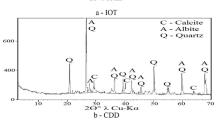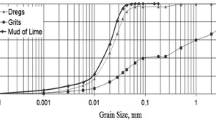Abstract
The rapid deterioration of the environmental situation comes mainly from environmental pollution by industrial and municipal wastes in the form of industrial and landfilled industrial and municipal wastes. The only way out of this threatening situation is the urgent utilization of all these wastes as valuable raw materials alternative to traditional natural materials. This article describes in detail the result of the complete replacement of natural materials with four industrial wastes—from iron ore processing, cellulose and pulp production, concrete production and demolition, and lime production—without changing the technological process nor creating new residues. The samples’ axial resistance values reached up to 4.94 MPa after 3 curing days, 5.75 MPa after 7 days, and 11.47 MPa on the 720th day of outdoor curing. The XRD, SEM, EDS, and LAMMA methods demonstrated the sol–gel solutions’ chemical interaction process and their gradual densification to a stone-like state. The developed materials have high mechanical and environmental properties and can be used to produce construction materials, such as bases of road and airfield runways, levee cores, industrial and municipal dumps, building foundations, bricks, and blocks.





Similar content being viewed by others
Data availability
No data, models, or code were generated or used during the study.
References
DNPM (2015) Sumario mineral National Department of Mineral Production - DNPM, Brasília, 2016
SNISB (2018) National Dam Registration Systems, National Dam Safety Information System - SNISB, Brasília
Liu H et al (2005) Metal contamination of soils and crops affected by the Chenzhou lead/zinc mine spill (Hunan, China). J Sci Total Environ 339:153–166. https://doi.org/10.1016/j.scitotenv.2004.07.030
Williams DV (2017) Tailings storage facilities. J Waste Manage 60:230–246. https://doi.org/10.1016/B978-0-444-63658-4.00037-2
Wang C et al (2014) Current state of fine mineral tailings treatment: a critical review on theory and practice. J Miner Eng 58:113–131
Stroeven P et al (2011) Research on cementitious materials to promote sustainable developments in Vietnam. Int Conf Conc Dev 1 Tehran. Proceedings. J Build Housing
IBAMA (2015) Technical report on the impacts of the Fundão dam rupture, Mariana, MG, Brazilian Institute of the Environment and Renewable Natural Resources - IBAMA, Brasília
Nuss P, Blengini GA (2018) Towards better monitoring of technology critical elements in Europe: coupling of natural and anthropogenic cycles. J Sci Total Env 613–614:569–578. https://doi.org/10.1016/j.scitotenv.2017.09.117
Do HS, Mun PH (2017) A study on engineering characteristics of asphalt concrete using filler with recycled waste lime. Waste Man 28:191–199
Monte MC et al (2009) Waste management from pulp and paper production in the European Union. J Waste Manage (Oxford) 29:293–308
Paper industry statistics & facts (2017) https://www.statista.com/topics/1701/paper-industry/
Iyaras A (2020) Combined effects of paper mill sludge and carbonation sludge on characteristics of fired clay bricks. J Con Build Mat 249:118722. https://doi.org/10.1016/j.conbuildmat.2020.118722
Hussain Z et al (2020) Production of bacterial cellulose from industrial wastes: a review J Cellulose 26:2895–2911
Gemelli E et al (2009) Evaluation of paper industry wastes in construction material. J Mat Res 4:297–304
Sebogodi KR et al (2020) Beneficiation of pulp mill waste green liquor dregs: applications in treatment of acid mine drainage as new disposal solution in South Africa. J Clean Prod 246:118979. https://doi.org/10.1016/j.jclepro.2019.118979
Silva RV et al (2014) Properties and composition of recycled aggregates from construction and demolition waste suitable for concrete production. J Con Build Mat 65:201–217
Hu X et al (2020) Utilization of fly ash and waste lime from pulp and paper mills in the argon oxygen decarburization process. J Clean Prod 261:121182. https://doi.org/10.1016/j.jclepro.2020.121182
Machado PJC et al (2020) Characterization and properties of cementitious composites with cellulose fiber, silica fume and latex. J Con Build Mat 257:119602. https://doi.org/10.1016/j.conbuildmat.2020.119602
Mokhena TC, John MJ (2020) John Cellulose nanomaterials: new generation materials for solving global issues. J Cellulose 27:1149–1194
European Commission (2018) EU Construction and Demolition Waste Protocol and Guidelines <https://ec.europa.eu/growth/content/eu-construction-anddemolition-waste-protocol-0_en> Accessed 17 July 2019
AGI (2014) Aggregate and the environment. American Geological Institute. Disponibilizado em: https://www.agiweb.org/environment/publications/aggregate.pdf Acessado em agosto de 2018
Islam R et al (2019) An empirical study of construction and demolition waste generation and implication of recycling. J Waste Manag 95:10–21
Bassani M et al (2019) Alkali-activation of recycled construction and demolition waste aggregate with no added binder. J Con Build Mat 205:398–413
Garside M (2020) Production of lime worldwide 2010–2019. https://www.statista.com/statistics/1006040/production-of-lime-worldwide/
NBR 6453 (2003) Lime for civil construction - requirements. Rio de Janeiro
Mymrin V (2019) Structure formation processes of sustainable construction material from hazardous sewage sludge with additions of wood ash, and lime production waste. J Advanced Manuf Tech. https://doi.org/10.1007/s00170-019-04408-4
Mymrin V et al (2017) Environmentally clean materials from hazardous red mud, ground cooled ferrous slag and lime production waste. J Clean Prod 161:376-381. https://doi.org/10.1016/j.jclepro.2017.05.109
CN-25–74 (2020) Guidelines for application of soils strengthened with binders for use in beds and pavements of roads and airfields. Moscow
NBR 9778 (2009) Hardened mortar and concrete - determination of water absorption, voids index and specific mass. Rio de Janeiro
NBR 248 (2003) Aggregates - determination of particle size composition. Rio de Janeiro
Foelkel C (2013) Practical and conceptual aspects on the manufacture of market cellulose of the kraft type bleached from eucalyptus wood. Chapter 31: The Kraft Pulp Making Process. Eucalyptus Online Book
Manskinen K et al (2011) Total and extractable non-process elements in green liquor dregs from the chemical recovery circuit of a semichemical pulp mill. J Chem Eng 166:954–961
Piotto ZC (2013) Eco-efficiency in the pulp and paper industry - case study. São Paulo
Zuccheratte A et al (2017) Synthetic gravel for concrete obtained from sandy iron ore tailing and recycled polyethyltherephtalate. J Con Build Mat 151:859–865. https://doi.org/10.1016/j.conbuildmat.2017.06.133
NBR 7170 (1983) Tijolo maciço cerâmico para alvenaria. Rio de Janeiro
Malaiskiene J et al (2018) The impact of primary sludge from paper industry on the properties of hardened cement paste and mortar. J Con Build Mat 172:553–561
NBR 6136 (2006) Blocos vazados de concreto simples para alvenaria – Requisitos. Rio de Janeiro
Mymrin V (1986) Theoretical bases of clay soils strengthening by dumped ground cooled ferrous slags for road base construction, Dr. of Sc. thesis, Moscow State University
NBR 10004 (2004) Solid waste classification, Rio de Janeiro, 2004
Zhao S et al (2014) Utilization of iron ore tailings as fine aggregate in ultrahigh performance concrete. J Con Build Mat 50:540–548. https://doi.org/10.1016/j.conbuildmat.2013.10.019
Acknowledgements
The authors would like to thank the Laboratory of Minerals and Rocks (LAMIR), the Ceramics Laboratory at UFPR, and the Multi-User Material Characterization Center (CMCM) at UTFPR, Curitiba, Brazil, for their dedicated technical assistance.
Funding
We included appropriate funding statements in the manuscript.
Author information
Authors and Affiliations
Contributions
All co-authors meet criteria for authorship and ensure appropriate acknowledgements made in the manuscript: Vsévolod Mymrin—author of the idea, developer of the plan of the experiments, participant of all stages of research, and author of the first manuscript’s version. Cleber L. Pedroso—performer of all principal laboratory studies and XRD analyses. Daniela E. Pedroso—bibliographical revision and performer of SEM analyses. Paulo H.B. Rolim—performer of all laboratory experimental works and co-author of this manuscript. Rodrigo E. Catai—performer of all laboratory experimental works and co-author of this manuscript. Karina Q. Carvalho—bibliographical revision and performer and co-author of this manuscript.
Corresponding author
Ethics declarations
Research involving human and animal participants
We show informed consent and provide assurances that participants’ rights are protected. We had no clinical trials and research using animals. We can sign a copyright agreement.
Conflict of interest
The authors declare no competing interests.
Additional information
Publisher's Note
Springer Nature remains neutral with regard to jurisdictional claims in published maps and institutional affiliations.
We declare that our manuscript was not published elsewhere.
Rights and permissions
Springer Nature or its licensor holds exclusive rights to this article under a publishing agreement with the author(s) or other rightsholder(s); author self-archiving of the accepted manuscript version of this article is solely governed by the terms of such publishing agreement and applicable law.
About this article
Cite this article
Mymrin, V., Pedroso, C.L., Pedroso, D.E. et al. Eco-friendly cementless concrete from hazardous iron ore tailing and waste of cellulose-pulp, concrete demolition, and lime production. Int J Adv Manuf Technol 122, 933–945 (2022). https://doi.org/10.1007/s00170-022-09811-y
Received:
Accepted:
Published:
Issue Date:
DOI: https://doi.org/10.1007/s00170-022-09811-y




